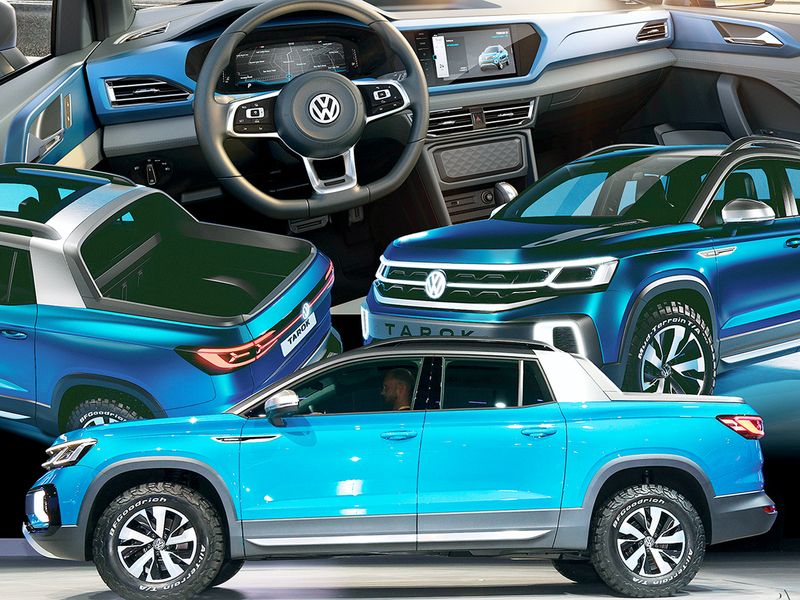
Over two successive springs and with two successive CEOs, Volkswagen a few years ago showed its dealers and loyalists concept unibody pickups that teased a possible reentry into a segment where it has long been absent.
But as competitors begin to roll out their own small lifestyle pickups, such as the Ford Maverick and Hyundai Santa Cruz, it appears a glaring white space in VW’s U.S. lineup — and perhaps its best hope of hitting its long-term market share aspirations — will remain unfilled, at least for now.
Duncan Movassaghi, executive vice president for sales and marketing for the VW brand in North America, says following others into the gasoline-powered small pickup space is no longer an option. But he did leave the door open a crack for a potential future electric vehicle with a bed.
“Our priority within the Volkswagen brand is to keep our existing [internal combustion engine-based] vehicles competitive” and to expand the battery- electric vehicle lineup, Movassaghi told Automotive News. “Investing at this time into a niche ICE [compact pickup] segment would not make sense for us. As we transform our lineup to BEV, an electric pickup could for sure be an option.”
VW dealers have long sought a pickup, a desire brand leaders in Virginia have been wrestling with for several years. Outside the U.S., the Amarok has been a proven player among compact pickups for a generation while being the only body-on-frame light-duty vehicle in the massive global brand’s whole portfolio. The next-generation Amarok will be based on the Ford Ranger — part of the automakers’ ongoing collaboration — but will remain forbidden fruit in North America.
“VW is still in rebuilding mode from Dieselgate, so they need to focus on building out vehicles that they have,” said Michelle Krebs, executive analyst at Autotrader. The German brand continues to be a niche player in the U.S., despite its aspirations to return to a 5 percent share here. In the first quarter, its U.S. market share stood at 2.3 percent.
Krebs predicted compact pickups “will do well. But for VW, bringing a small electric pickup truck to the market might make sense in the future. We know from our survey work that there is some interest in electric pickups, and a small EV pickup could make sense, especially for young California buyers.”
VW has a history in the U.S. with small unibody pickups, though its success was limited. More than four decades ago, the brand used its then-popular Rabbit as the basis for a small bedded vehicle it simply called the Pickup. The front-wheel-drive truck was built in the U.S., had a single row of seating and a 6-foot bed, and was identical to the Rabbit from the doors forward. From 1979 to 1983, the brand sold just 77,512 Pickups in the U.S., though the design lived on elsewhere around the world for 20 more years.
In 2018, under then-North American chief Hinrich Woebcken, the brand showed an Atlas-based concept at the New York auto show called the Tanoak, which was roughly equivalent in size to a Honda Ridgeline midsize pickup. Woebcken and the brand admitted there were no immediate plans to produce the unibody pickup, but he said the concept “shows that we are thinking about what may also be possible, someday in the future, in this market.”
A year later, under new VW Group of America CEO Scott Keogh, it showed the smaller Tarok concept in New York. The Tarok, like the Tanoak, was built on the automaker’s MQB platform. It had two full rows of seating and a small, squarish bed with an innovative drop wall and folding seats that made for a bed length of more than 8 feet with the tailgate down. The Tarok is now on sale in South America.
Karl Brauer, executive analyst at iSeeCars.com, says VW is having more success in building its crossover lineup. He said introducing a pickup like the Tarok or Tanoak concepts probably proved too great a risk.
“Pickups are a completely unproven entity for them,” Brauer said. “They could do a truck, and it probably wouldn’t crash and burn, but given the investment and resources, investing into another [crossover] was probably safer.”
Keogh, speaking to Automotive News in 2019 about the Tarok, said: “The question we have is, could something like this make sense, with modifications, in the U.S. market? The theory is quite straightforward: It’s an A-segment-sized vehicle. There’s no pickup truck in the U.S. market that is quite that size at all.”
It’s a theory both Ford and Hyundai — but not VW — are now willing to explore.